- Top Trumpet Embouchure Techniques: Options for Beginners Through Professionals - October 12, 2022
- Is the Trumpet Hard to Learn? - September 30, 2022
- Best Leblanc Clarinet Models Guide: From Soprano to Contrabass - September 5, 2022
When you think of a clarinet, you probably think of something squeaky and high-pitched. But if you know how to find the best contrabass clarinet, you can help round out the low end of an ensemble.
You can also avoid some of the squeaky high notes that you might play on the B flat clarinet. Then, you can enjoy playing music without feeling pressured to sound perfect.
What Is A Contrabass Clarinet?
A contrabass clarinet is a larger member of the clarinet family. It’s in the key of B flat, which is the same key as the standard clarinet and the bass clarinet.
However, it reads the same written notes as the other clarinets, so you can more easily switch between the instruments. Because the instrument is so big, it plays an octave lower than the bass clarinet and two octaves lower than the regular B flat clarinet.
The contrabass clarinet isn’t super common, but there are parts for it in a wind ensemble and sometimes in an orchestra. You can also hear the instrument in a clarinet choir, which has parts for many different clarinets.
How To Find The Best Contrabass Clarinet
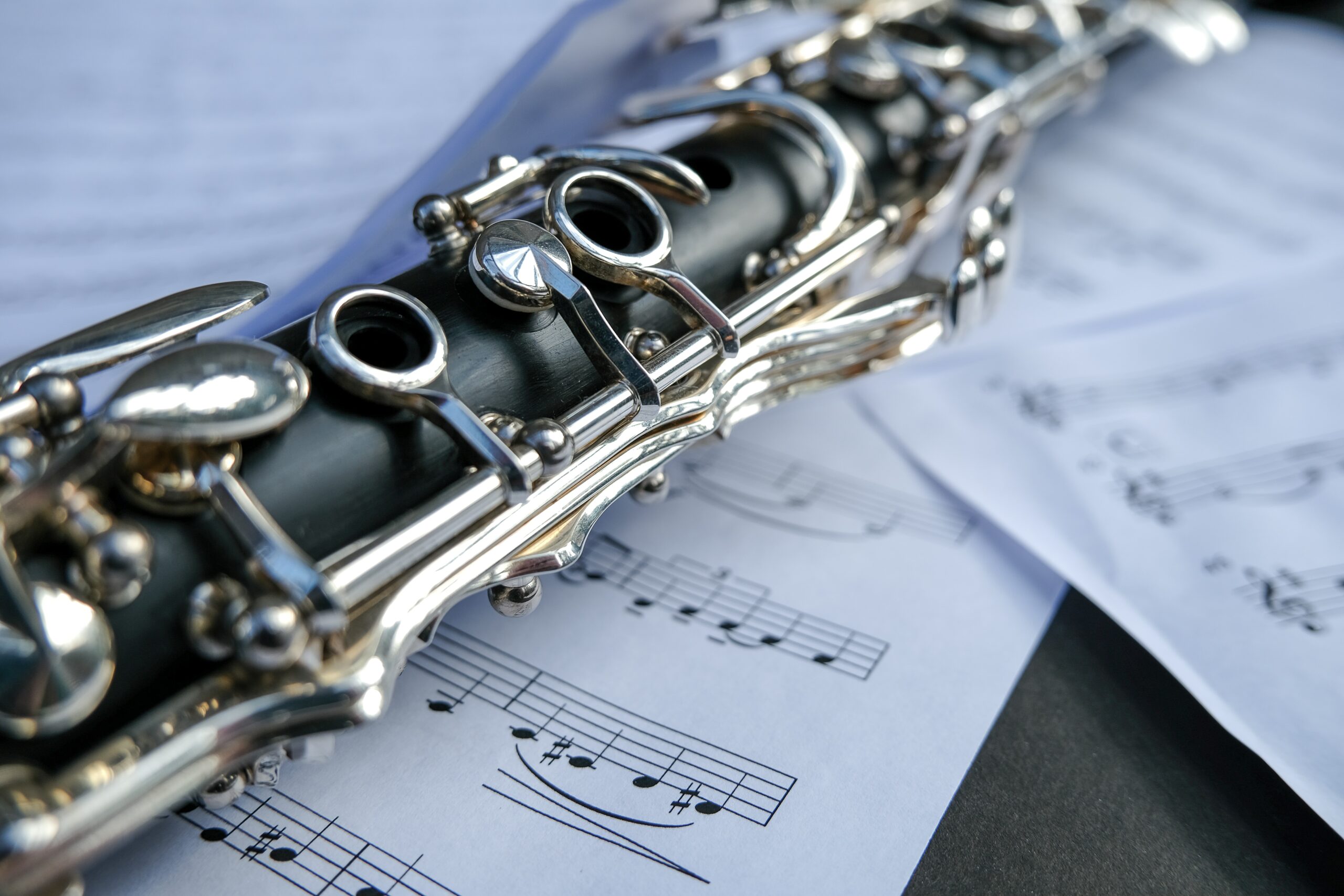
If you want to expand your clarinet skills after learning the B flat clarinet, bass instruments are a great option. You can learn from other members of the clarinet family to gain experience and open yourself up to different gigs. But as with other clarinets, you shouldn’t have to play on a poor quality contrabass. If you know how to find the best contrabass clarinet, you’ll make learning to play it much easier on yourself.
As you shop around for your perfect instrument, you should have a plan. That way, you won’t buy a contrabass clarinet just because it’s available to you.
Play Other Clarinets
Unfortunately, the contrabass clarinet isn’t very suitable for beginner clarinet players. You should take some time to learn how to play the B flat clarinet. Then, you can learn how to read music, how to produce different notes, and how to breathe well.
If possible, try to play the bass clarinet as well to make your transition to the contrabass clarinet go more smoothly. You can use the bass clarinet to experiment with lower sounds, and you can play it more often than the contra.
Playing other clarinets can also help you decide if you like that family of instruments. The contrabass clarinet sounds and looks great, but developing your fundamentals on the clarinet can help you save money and time in case you don’t like to play it.
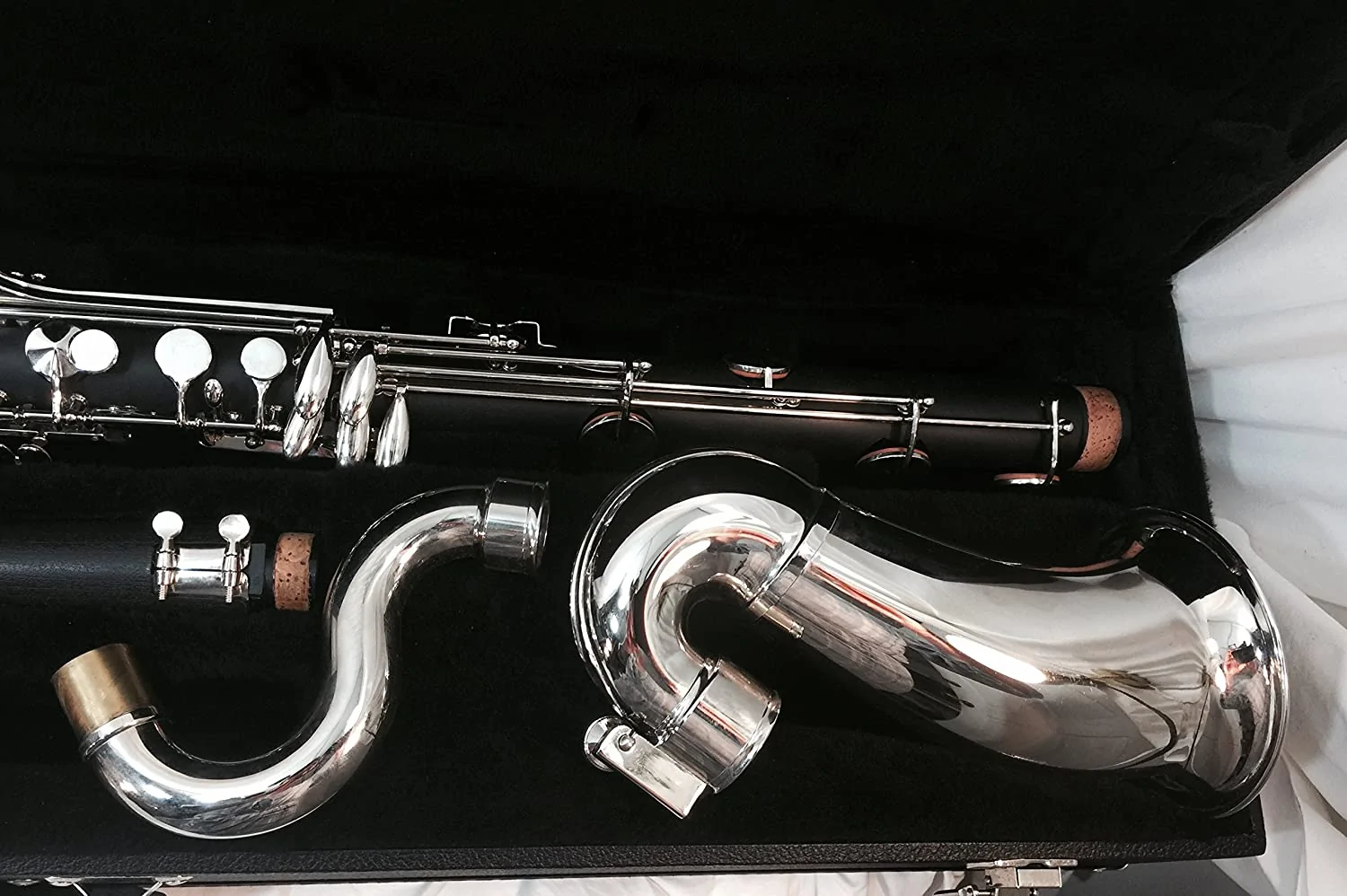
Research Specs
As you learn how to play the clarinet and bass clarinet, take some time to learn about contrabass clarinet specs. The specs aren’t that different from those of the smaller instruments. But you should get an idea of the specs you need or want in a contrabass clarinet. Odds are, you probably won’t buy another contrabass for a while, so this purchase needs to last you for years.
That can mean saving more money for upgrades to the instrument itself. It can also mean waiting a while to buy an instrument with the specs you need. For example, some contras have a range that goes to low E flat, while others go down to a low C. You can find contras in both plastic and wood, with wood being more expensive.
Get Some Accessories
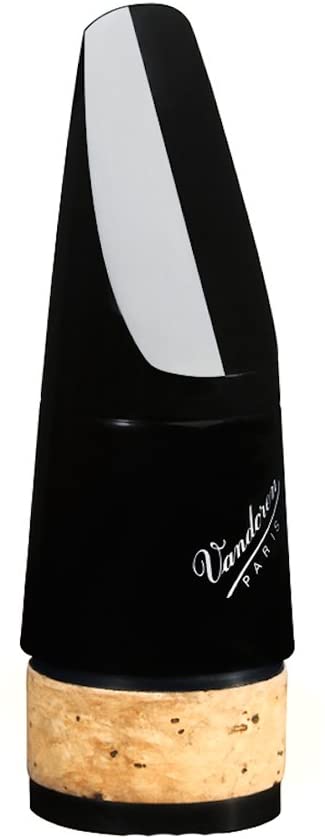
After you get a grasp on playing the clarinet, you’ll need to buy separate accessories for the contrabass. The different size means your current mouthpiece and reeds won’t work. You can get a good contrabass clarinet mouthpiece and reeds to help practice making a sound. Then, you will know how to form your embouchure when you try contra bodies.
Pair it with some good-quality contra reeds, and you can practice blowing in just the mouthpiece. The accessories are an affordable way to introduce yourself to the instrument. And you can use them to better compare instruments later.
Start Saving
As soon as you know you want to find the best contrabass clarinet, you need to save money. Some contrabasses are relatively affordable, but they’re all much more expensive than comparable clarinets.
The more you can save now, the better the chance you’ll have of buying the clarinet in full. Even if you can’t do that, you can put down a bigger downpayment to help lower your monthly payments.
Speaking of which, if you know you won’t have the full amount ready, look for a financing program. Many music stores will let you finance instrument purchases over a set period, but you still need to make sure you’ll have the money for it.
Consider Used Contras
One of the easiest ways to lower the cost of a contrabass clarinet is to look for a used one. Finding a used model isn’t always easy, so you might need to be patient. But if you’re in no rush to get an instrument, you can shop around on the used market. You might be able to get a great deal on an instrument that the seller has hardly played.
Another benefit of used instruments is that you can spend the amount you were planning to, but you can get something of better quality. That way, you won’t have to upgrade to a more professional model as soon.
Try More Than One
The next step in how to find the best contrabass clarinet for you is to try at least two instruments. You may luck out and decide the first one you try is the model for you. However, you should try a second one so that you can compare the two. That way, you’ll know for sure if you have an instrument that will best serve your needs. If not, you can go with the second contra or try even more models.
In fact, you may want to try multiple instruments of the same model. Sometimes, the same clarinet can have slight differences because of whoever helped make it. If you’re looking at handmade instruments, those differences can affect your playing. Try at least a couple of contrabass clarinets from the same and different companies to ensure you’re getting the one for you.
Play-Test Them
Once you get access to a couple of contrabass clarinets, put them through a series of tests. Use the same mouthpiece and reed to help control for any differences in the instruments.

Play the lowest and highest notes to see and hear how they respond and sound. Find something slow and something fast so that you can test the mechanism and tone colors.
Keep all of these tests the same on each contrabass clarinet you try. That will make it easier for you to compare all of them, so there shouldn’t be a question on which instrument is best for you.
Ideally, you’d try a few contrabass clarinets at the same time to help compare them. If that’s not an option, record yourself on each one and listen back to make your decision.
Listen Back
Recording yourself can also help if you try two models back to back. When playing an instrument, you can easily focus on what you’re playing instead of what you’re hearing.
If you record yourself, you can listen to the recording after to hear what a listener might hear. You can also send the recordings to a teacher or another musician to get their thoughts.
The other musician can even come with you to try contrabass clarinets, so they can listen live. Having someone else to judge the instruments can help you evaluate if a model is a good fit or if it just seems that way.
Keep Searching
Since the contrabass clarinet isn’t super popular, you may not find the right one during your first trial session. However, don’t let that discourage you from playing it and shopping around. Look for other models and wait for more stock to come into your local music store. The next batch of contras may include your perfect instrument, so let the store know you want to keep trying.
You can also search for used contrabass clarinets and try those to broaden your search. Sometimes, a used instrument is what you need to improve your playing.
The Best Contrabass Clarinets
Knowing how to find the best contrabass clarinet is great, but it doesn’t cover the entire process of instrument shopping. You also need to know about some of the best contras on the market.
Not only will that help you follow the steps to choose your dream contrabass, but it will help you narrow your search. That way, you can avoid wasting your time on instruments from brands that don’t have a good reputation for making instruments.
Sadly, there aren’t a ton of great contrabass clarinet models. However, there are a couple that you can try at the start of your contrabass clarinet journey.
This is an extremely tough instrument to find if you want to buy one. I did another thorough search to find these two models. The two models I included are the only contrabass clarinets available. Some other models pop up when I search for contrabass clarinets, but they’re either bass clarinets or contra-alto clarinets. They aren’t really useful when it comes to getting a contrabass clarinet since the bass is a different instrument, and the contra-alto is in a different key so can’t play the same music.
Leblanc Model 7182
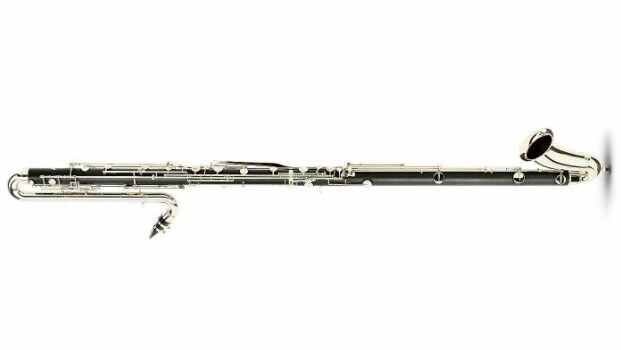
The Leblanc Model 7182 is an excellent option for new contrabass players. It offers a dark and deep tone that helps fill out the low clarinet section in a band or clarinet choir.
This model has a one-piece plastic body with a finish that looks like wood. That design means you don’t have to line up the joints like on a B flat clarinet, so assembly is easy. And you can play the instrument outside without it cracking.
You can play down to the low E flat with this model which is standard among low clarinets. It has conical pad cups, and the cone shape helps with the sound. The neck, bell, and keys all use silver plating, which can help bring down the instrument cost. It’s a fantastic upgrade from an older model, but new contra players can learn on it as well.
Pros
- Durable
- Great design
- Somewhat affordable
Cons
- Hard to play loud
- Can’t adjust the playing height
Selmer Paris Model 41
If you’re a serious contrabass clarinetist or simply want something more professional, the Selmer Paris Model 41 is for you. This clarinet has a rosewood body, and it offers a full, rich sound.
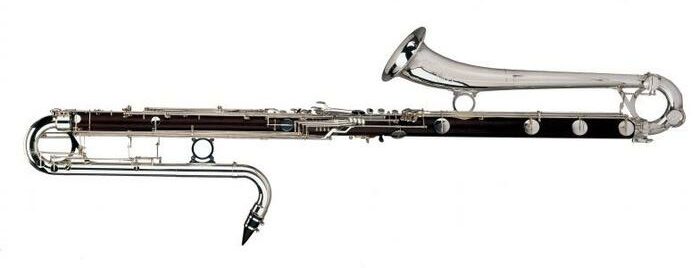
You can use this instrument to project well, even when playing in a concert band. It has a big bore, which helps you get a full sound, and there’s an articulated G sharp key. Plus, this model goes down to a low C, so you can play almost any contrabass clarinet part that exists. The bell, keys, and neck feature silver plating, which helps offer a warm sound without costing too much.
However, this instrument isn’t for a beginner. It costs more than some cars, so you’ll need to commit to playing it to get your money’s worth. But it can be a good option for colleges and other music groups that need a contrabass clarinet.
Pros
- Warm and full sound
- Projects well
- Low C
- Great for professionals
Cons
- Not for beginners
- Requires a huge budget
FAQs
Answer: Playing the contrabass clarinet can be a great way to stand out amongst other clarinet and bass clarinet players. You can add some oomph to the bass line, and you can show that you’re willing to play different instruments.
The contra also has some cool low parts. Even though a lot of it may be a slow-moving bass line, there are some low solos in pieces like Symphony No. 1 by John Corigliano.
Answer: Believe it or not, the contrabass clarinet isn’t the biggest member of the clarinet family. The octocontralto and octocontrabass clarinets are bigger, with the octocontrabass being the biggest and playing an octave below the contrabass.
However, the contrabass clarinet is the biggest member that you see regularly. The lower clarinets are rarer, so you probably won’t ever see or play them.
Answer: The lowest note on the contrabass clarinet is the same written note as on the bass clarinet, which is the C an octave below middle C. However, the contrabass is in the key of B flat, so it sounds two octaves and a major second below the written note.
Its lowest sounding note is the D flat over an octave below the bass clef, or the B flat below that with a low C. That’s the same as the lowest D flat and B flat on the piano.
The contrabass clarinet can play up to a written C above the treble clef. This corresponds to the B flat just below middle C.
Answer: The contrabass clarinet tends to have easier parts than the B flat and bass clarinets. However, you’re usually the only one playing the contrabass, so you have to cover any solos and other parts of the instrument.
You also need to have good air support and be able to breathe well to play the contra. Because of that, it can be harder to play, even though the parts aren’t as technically challenging.
Answer: You can switch between the two low clarinets in the same rehearsal or performance. But you shouldn’t quit playing the bass clarinet in favor of the contrabass.
The bass clarinet has more parts in ensembles, so you’ll be able to play it more. Luckily, adding the contrabass to your skills can give you even more performance opportunities.
Answer: The B flat clarinet is probably the easiest clarinet to play for new clarinetists. If possible, you should play it before learning the bass or contrabass clarinet.
Switching to the lower instruments will be easier, and you can get started on the B flat clarinet on a smaller budget. Then, you can decide if you want to learn other clarinets.
Answer: If you straightened the instrument out, it would be about 8.85 feet (2.7 meters) long. However, the contra features a curve at the top and bottom to help make it easier to play.
Answer: Good contrabass clarinets can cost anywhere from $5,000 to $35,000 or more. They cost a lot because they use a lot more materials than other clarinets due to their size.
And since they aren’t super common, odds are music stores don’t buy them in bulk, which would potentially lower the price. So both manufacturers and sellers need to make a profit by selling the instrument for more.
Answer: Your best bet when it comes to renting a contrabass clarinet is to borrow one from a college or high school music program. To do that, you’ll probably need to be part of the band or orchestra.
Otherwise, you can ask around and find a clarinet player who owns a contrabass that you can borrow. Then, you can test the instrument before you buy one yourself.
Final Note On How To Find The Best Contrabass Clarinet
Whether you’re a student or professional, you should play as many clarinets as you can. But that means knowing how to find the best contrabass clarinet. Unfortunately, some contrabass clarinets cost more than some cars, so it can be hard to find a good one in your budget. Luckily, you can test a few models, look for a used one, or even borrow a contrabass to start learning.
Then, you can know what to look for when shopping for the best contrabass clarinet for you.



